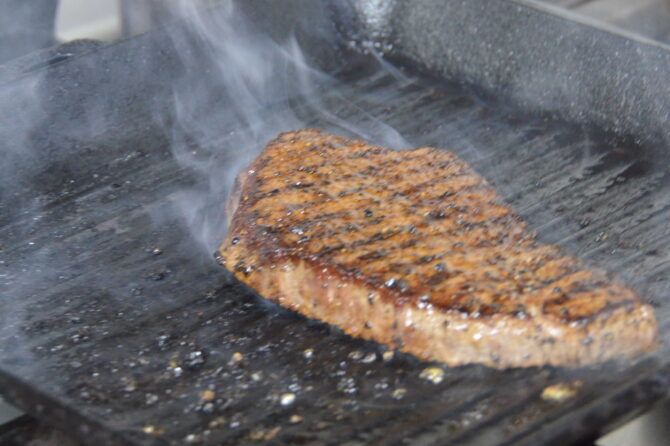
How to Grill the Perfect Angus Steak at Home
Nothing compares to the satisfaction of preparing and enjoying a perfectly grilled Angus steak in your own backyard. Known for its rich marbling, tenderness, and bold flavor, Angus beef is considered the gold standard for steak lovers worldwide. With the right techniques, you can turn a simple cut of beef into a restaurant-quality experience at home. Here’s everything you need to know about how to grill Angus steak to perfection.
Why Angus Beef?
When it comes to steak, the quality of the beef matters just as much as your grilling skills. Angus beef is prized for its superior marbling, tender texture, and consistent results. The fine streaks of fat that run through the muscle melt during cooking, making every bite juicy and full of flavor. That balanced fat-to-muscle ratio promotes tenderness across different cuts and helps steaks cook evenly over high heat.
Choosing Angus also means choosing reliability. Properly raised Angus consistently delivers naturally tender, flavorful beef that sears beautifully — one reason it’s a favorite for home cooks and professional steakhouses alike.
Choosing the Right Cut for Grilling
Before you light the grill, select the cut that matches your taste and cooking style. Aim for steaks that are 2.5–4 cm (1–1.5 in) thick to make searing and finishing easier.
- Ribeye Angus: The ultimate choice for marbling, juiciness, and bold beef flavor.
- Striploin (New York Strip): A balance of tenderness and lean meat — great for classic steak dinners.
- Tenderloin (Filet Mignon): Buttery-soft and delicate, perfect for special occasions and quick searing.
- Sirloin: Affordable, flavorful, and versatile — ideal for everyday grilling.
No matter which cut you choose, start with beef from a trusted source. High-quality, naturally raised, traceable Angus guarantees superior taste and consistent results.
Step-by-Step Guide: How to Grill Angus Steak
Follow these fundamentals for steakhouse-level results at home:
- Bring Steak to Room Temperature: Remove your Angus steak from the refrigerator and let it sit until the chill is off the center (up to 1–2 hours, depending on thickness). Never use hot water or a microwave — those methods damage texture and dilute flavor. Pat the surface dry with paper towels to promote better browning.
- Season Simply but Generously: Classic seasonings are best: sea salt, freshly cracked black pepper, and an optional touch of garlic powder. Season at least 30 minutes before grilling (or just before searing) to let salt begin dissolving on the surface for a deeper crust.
- Preheat and Prep the Grill:
- Target heat: 230–260°C (450–500°F) for a strong sear.
- Gas grill: Preheat on high with the lid closed for 10–15 minutes.
- Charcoal grill: Build a two-zone fire (hot side for sear, cooler side for finishing).
- Clean & oil grates: Brush grates clean, then lightly oil to minimize sticking.
- Sear, Then Finish to Target Doneness: Place the steak directly over high heat and sear for 2–3 minutes per side to develop a deep crust. Move it to indirect heat to finish gently. Use an instant-read thermometer for accuracy, pulling the steak 2–3°C (3–5°F) before your target to account for carryover cooking.
- Rare: 49–52°C (120–125°F)
- Medium Rare: 54–57°C (130–135°F)
- Medium: 60–63°C (140–145°F)
- Medium Well: 65–68°C (150–155°F)
Timing tip: For a 2.5–3 cm (1–1.25 in) ribeye or strip, expect about 2–3 minutes per side to sear, then 3–6 minutes on indirect heat to reach medium-rare, depending on grill intensity and steak thickness.
- Rest, Slice, and Serve: Transfer the steak to a warm plate or board, tent loosely with foil, and rest 5–10 minutes. Resting allows juices to redistribute, keeping each bite tender and succulent. Slice against the grain for maximum tenderness. Optional: finish with a knob of butter, a drizzle of olive oil, or fresh herbs.
Pro Tips for Next-Level Results
- Dry the surface well: Moisture blocks browning; a dry steak sears faster and better.
- Flip once (or twice at most): Minimize flipping to develop an even crust.
- Avoid pressing the steak: Pressing squeezes out precious juices.
- Use the two-zone method: Hard sear first, then finish gently to your exact doneness.
- Try compound butter: Mix softened butter with garlic and herbs; melt over the hot steak at serving.
For more preparation techniques for different cuts of Angus beef, visit: https://mountainhighfarms.net/en/preparation-3/
The Role of Traceability and Natural Farming in Taste
Grilling Angus steak isn’t just about cooking — it’s also about the story behind the beef. Naturally raised Angus cattle, fed on pastures and raised without hormones or unnecessary antibiotics, tend to produce meat with cleaner, richer flavor. Traceability ensures you know exactly where your steak comes from and how it was raised.
Choosing beef from farms that practice regenerative agriculture and sustainable grazing supports animal welfare, healthier ecosystems, and consumer trust. With traceable Angus beef, you get peace of mind knowing your steak is both ethically raised and nutritionally robust.
Final Thoughts
Learning how to grill Angus steak at home is a skill every beef enthusiast can master. With the right cut, simple seasoning, and a properly heated grill, you can achieve steakhouse-quality results in your backyard. And when you choose naturally raised, fully traceable beef, you’re not just enjoying a great steak — you’re making a healthier and more responsible choice.
The next time you fire up the grill, keep it simple: choose a premium cut of Angus, season it well, and let the quality of the beef speak for itself. Mountain High Farms: Where traceability meets taste.
Leave a reply


Leave a reply